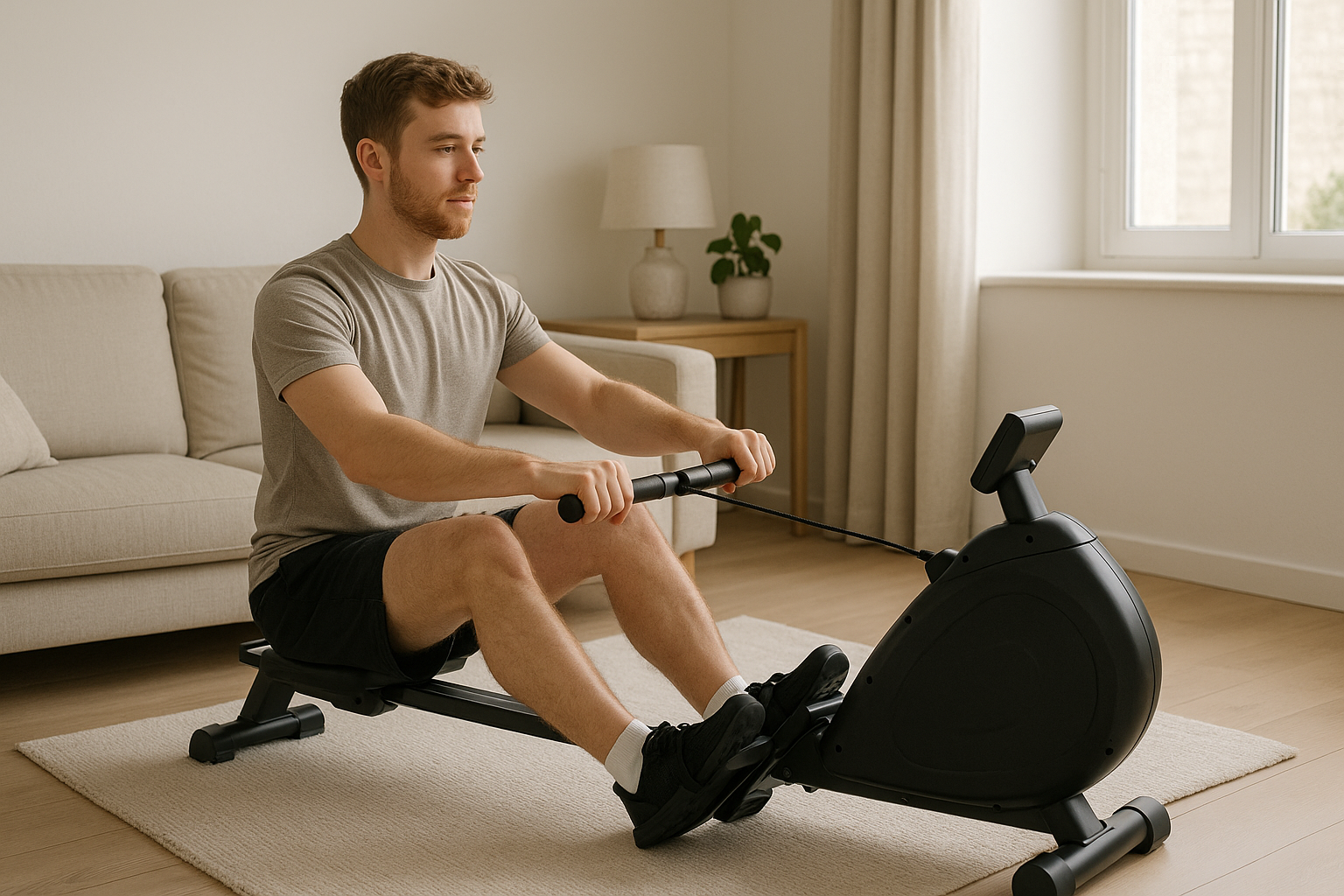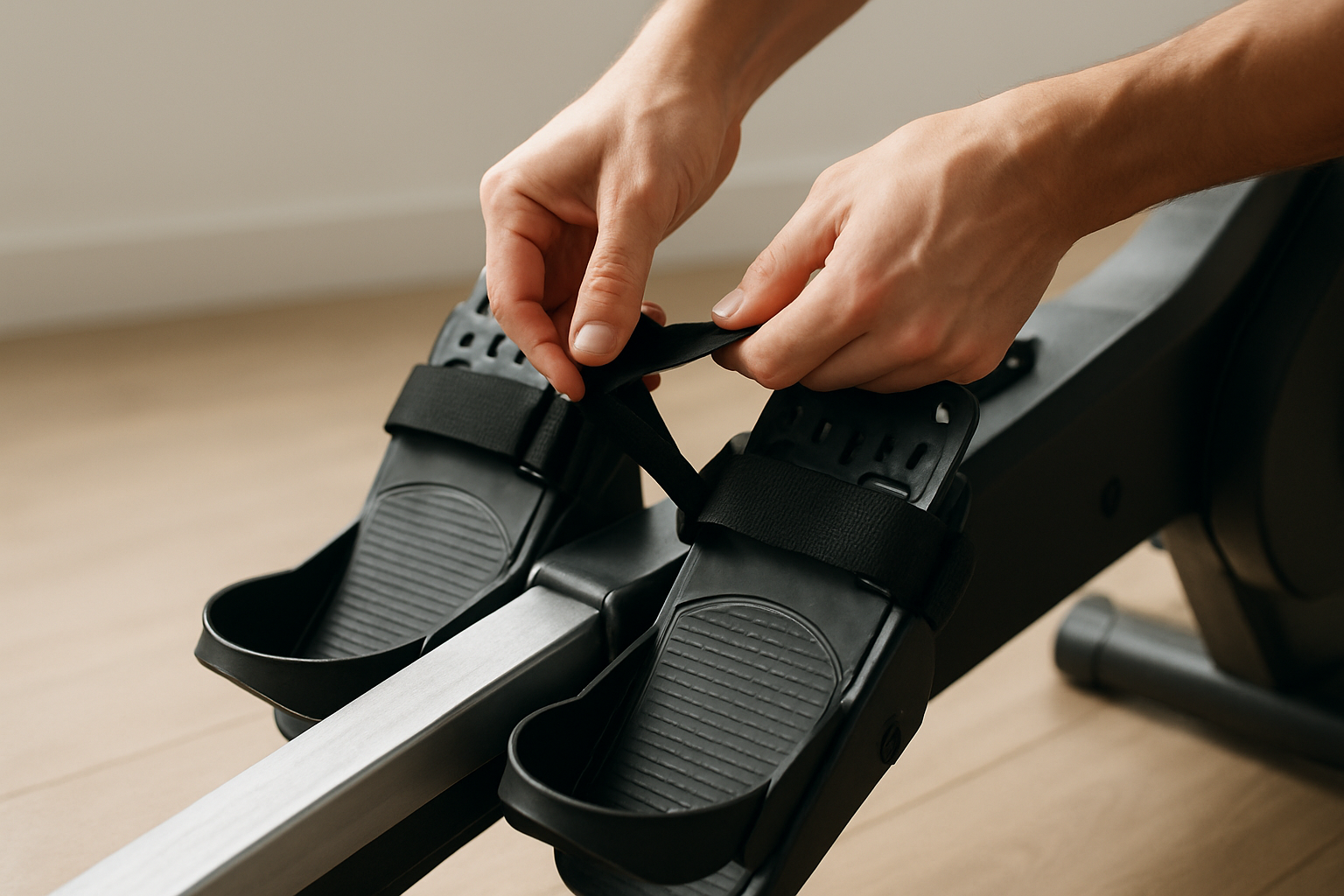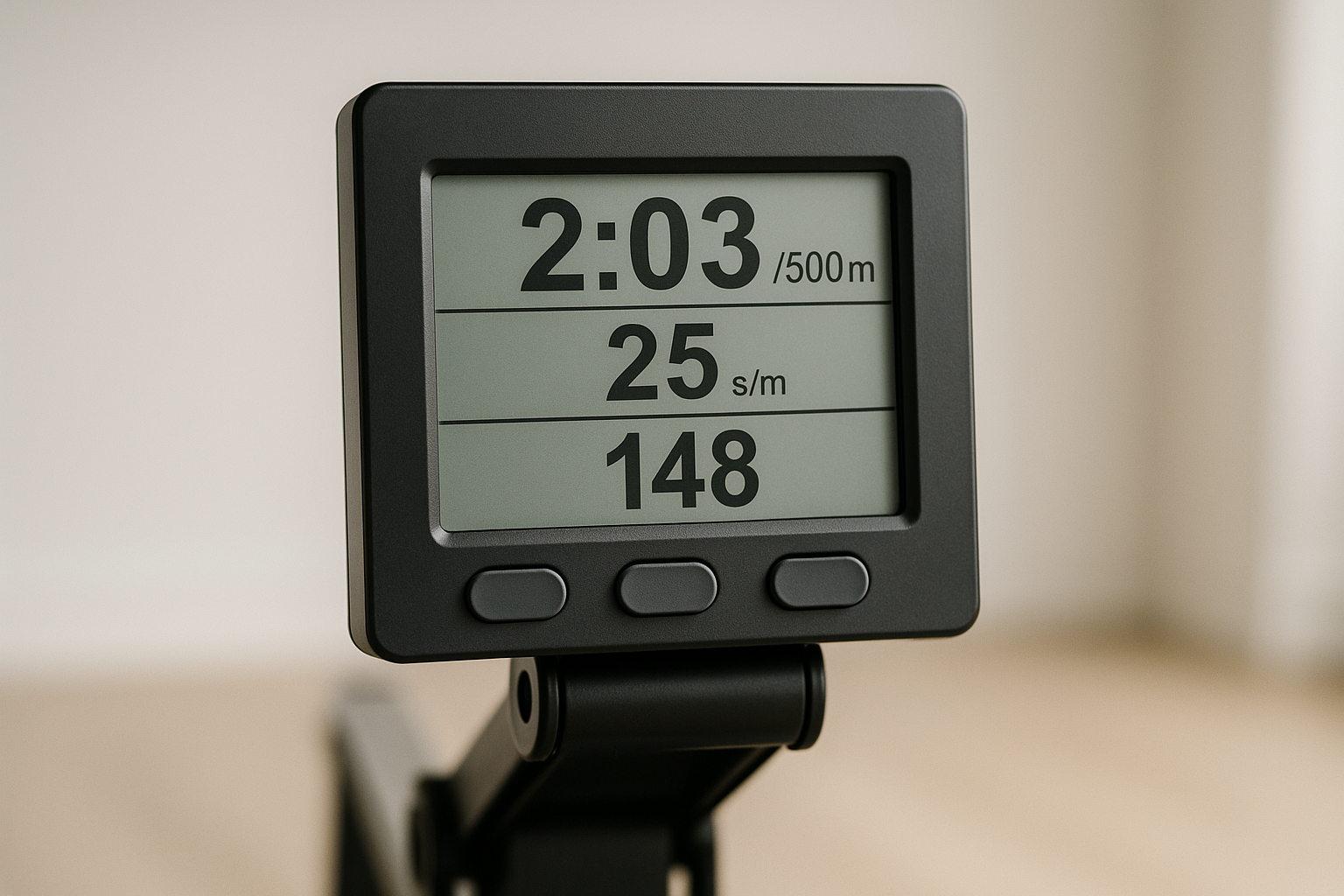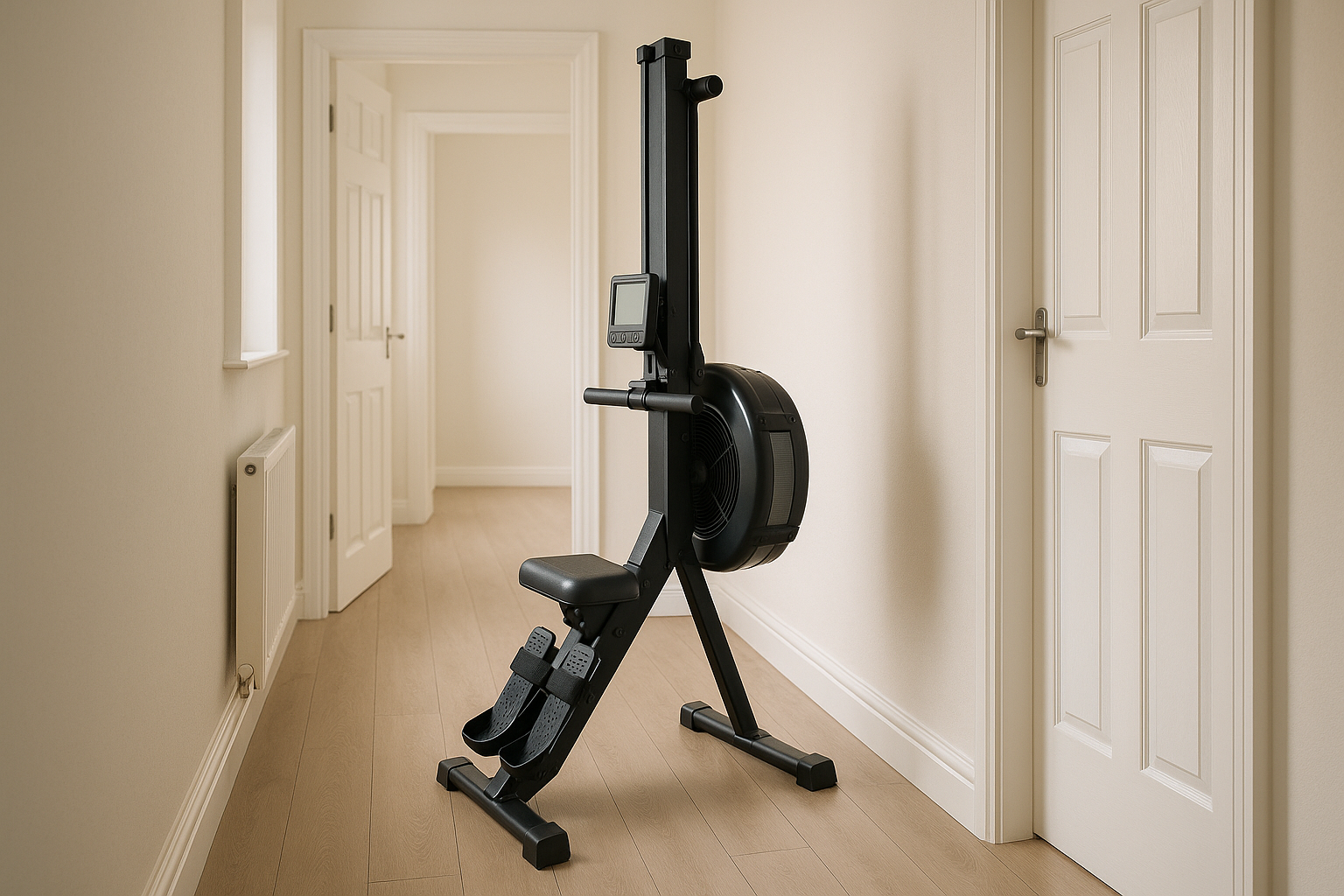Beginner Rowing Machine Workout Plan (UK): 6 Weeks to Fitter, Stronger Cardio at Home
Beginner Rowing Machine Workout Plan (UK): 6 Weeks to Fitter, Stronger Cardio at Home
Reading time: 12 minutes
Last updated: September 2025
If you’re new to indoor rowing and want a clear, safe path to better cardio and full‑body strength at home, this beginner rowing machine workout plan delivers. In six weeks you’ll build technique, endurance and confidence with short, structured sessions that fit busy UK schedules and small spaces. Expect practical guidance on form, pacing, heart rate zones and simple progressions—plus fixes for common mistakes.
- TL;DR:
- Three structured sessions per week for 6 weeks; 20–35 minutes each.
- Technique first: efficient catch–drive–finish–recovery pattern and stroke rates (spm) to target.
- Progress from easy steady rows to short intervals and threshold efforts, guided by RPE/HR zones.
- Low-impact, joint-friendly conditioning that works legs, core and back together.
- Beginner plan plus optional intermediate and advanced progressions.
- Includes warm-up, cooldown, mobility, nutrition and injury-prevention tips.
Beginner rowing machine workout plan: what to expect in 6 weeks
A beginner rowing machine workout plan is a structured programme that blends technique, easy steady rows and short intervals so you can progress safely without overdoing it. In this 6-week plan you’ll row 3 days per week for 20–35 minutes, using simple metrics—rate (spm), split time/pace and RPE (effort)—to guide your training.
By week 6, most beginners can row 30 minutes continuously at a comfortable steady pace and complete short threshold efforts with good form. Because indoor rowing is low-impact and full-body, it’s ideal for improving cardiovascular fitness while being kind to knees and ankles.

Why row? Evidence-based benefits for beginners
- Heart health and endurance: Rowing meets UK Chief Medical Officers’ guidance for moderate to vigorous aerobic activity (150–300 minutes/week moderate or 75–150 minutes vigorous) when combined with walking and daily activity. See the UK CMO Physical Activity Guidelines.
- Low-impact, full-body work: Legs, hips, back, core and arms share the load—joint-friendly compared with running.
- Strength-endurance: Repetitive, coordinated power builds muscular endurance alongside cardio.
- Time-efficient intervals: Short, structured efforts can improve fitness in limited time. The NHS supports building up intensity gradually to reduce injury risk (NHS exercise guidance).
Equipment and home setup
You can follow this plan on any functional ergometer (air, magnetic or water). Key setup factors for UK homes and flats:
- Space: Most rowing machines are ~2.1–2.4 m long. Measure your available length and clearance behind the seat for full strokes.
- Noise: Air rowers are the noisiest; magnetic are quietest; water rowers sit between. For flats, consider a mat to dampen vibration.
- Footplate and handle: Adjust foot straps across the widest part of your foot. Neutral wrist grip; don’t death-grip.
- Resistance: Start moderate. On air rowers, avoid high damper settings until technique is consistent.
Choosing your first erg? Compare options in our best rowing machines guide. If you prefer the feel of air resistance and simple durability, you might also like our detailed BodyMax Oxbridge HR Air Rowing Machine review.

Technique: the 4-phase stroke (with cues)
Efficiency comes from sequencing legs, then body, then arms. Keep the stroke smooth and consistent.
- Catch: Shins vertical, heels lightly down, neutral spine, shoulders in front of hips. Lats engaged, eyes forward.
- Drive: Push the footplate away with the legs; torso stays braced; arms straight. When legs are nearly straight, swing the body to ~11 o’clock, then draw the handle to lower ribs.
- Finish: Handle brushes the body; elbows back and down; wrists flat; shoulders relaxed.
- Recovery: Arms away first, then body pivots to 1 o’clock, then knees bend. Slow the recovery slightly longer than the drive (2:1 rhythm).
Pro tips
- Think “legs, body, arms” on the drive; “arms, body, legs” on the recovery.
- Keep stroke rate controlled (18–24 spm steady; 26–30 spm for short intervals).
- Breathe out on the drive; in on recovery.
Common mistakes
- Pulling early with arms; rushing the slide.
- Over-reaching with rounded back at the catch.
- Cranking damper too high—form collapses under load.

Diagram suggestion: a four-frame sequence with arrows noting legs–body–arms on the drive, arms–body–legs on the recovery.
Warm-up and cooldown
Warm-up (6–8 minutes)
- 2 minutes easy row (RPE 2–3) at ~18–20 spm.
- 2 minutes technique drills: 5 strokes arms-only, 5 strokes arms+body, 10 full strokes; repeat.
- 2–4 minutes progressive row: increase to RPE 4–5 and 22 spm.
Cooldown (5–7 minutes)
- 3–5 minutes easy row at 18 spm, breathing down.
- Light mobility: hip flexors, hamstrings, thoracic rotations, and forearm stretches.
Training zones, stroke rate and metrics
- RPE (Rate of Perceived Exertion, 1–10): Simple and effective for beginners. Steady = RPE 3–4; Threshold = RPE 7; Short intervals = RPE 6–8.
- Heart rate: If tracking, Zone 2 ≈ 60–70% HRmax; Threshold ≈ 80–88% HRmax. Build gradually as per NHS guidance.
- Stroke rate (spm): Keep steady sessions at 18–22 spm. Use power per stroke, not just higher rate, to go faster.
- Split/pace: Many monitors show pace per 500 m. Your pace will naturally improve as technique and fitness build.
The 6-week plan (Beginner, plus progressions)
Row 3 days per week on non-consecutive days (e.g., Mon–Wed–Sat). If you already do other cardio 2–3 days per week, consider the intermediate progression. Always prioritise technique quality over pace.
Week 1
- Session A: 3 x 6 minutes steady (RPE 3–4, 18–20 spm), 2 minutes easy between.
- Session B: Technique focus + 8 x 1 minute (RPE 6, 24–26 spm) / 1 minute easy.
- Session C: 20 minutes continuous steady (RPE 3–4, 20 spm).
Week 2
- Session A: 2 x 10 minutes steady (RPE 3–4, 20 spm), 3 minutes easy.
- Session B: 10 x 1 minute (RPE 6–7, 26 spm) / 1 minute easy.
- Session C: 24 minutes continuous steady (RPE 4, 20–22 spm).
Week 3
- Session A: 3 x 8 minutes steady (RPE 4, 20–22 spm), 2 minutes easy.
- Session B: Threshold set: 3 x 5 minutes (RPE 7, 24–26 spm), 2 minutes easy.
- Session C: 26 minutes continuous steady (RPE 4, 20–22 spm).
Week 4
- Session A: 2 x 12 minutes steady (RPE 4, 20–22 spm), 3 minutes easy.
- Session B: 6 x 2 minutes (RPE 7, 26–28 spm) / 90 seconds easy.
- Session C: 28 minutes continuous steady (RPE 4, 20–22 spm).
Week 5
- Session A: Pyramid: 4–3–2–1–2–3–4 minutes (RPE 6–7, 24–26 spm), 1–2 minutes easy between reps.
- Session B: 12 x 1 minute (RPE 7–8, 26–30 spm) / 1 minute easy.
- Session C: 30 minutes continuous steady (RPE 4, 20–22 spm).
Week 6
- Session A: 3 x 8 minutes steady (RPE 4, 20–22 spm), 2 minutes easy.
- Session B: Threshold set: 2 x 8 minutes (RPE 7, 24–26 spm), 3 minutes easy.
- Session C: 30–32 minutes continuous steady (RPE 4, 20–22 spm). Optional negative split: gradually quicken each 10-minute block with form intact.
Optional intermediate progression (4 days/week)
- Add a fourth easy Zone 2 row of 20–25 minutes each week.
- Push threshold sets to 3 x 8 minutes by week 6 if form remains solid.
Optional advanced progression (5 days/week)
- Two steady rows (30–40 minutes), one threshold set, one short-interval set, one technique/recovery row.
- Keep at least 48 hours between high-intensity sessions.

Injury prevention, recovery and sleep
- Dose wisely: Follow the plan’s rest days. Escalating volume too fast is the main risk for niggles.
- Back-safe form: Neutral spine, hinge from hips, brace lightly before each drive. For persistent back pain, consult guidance such as NICE NG59 and seek professional advice.
- Mobility: 5–8 minutes of hips/hamstrings/thoracic mobility after rows supports posture and stroke length.
- Sleep: Aim for 7–9 hours. Sleep supports adaptation and reduces injury risk.
Medical disclaimer: If you’re new to exercise, have cardiovascular, musculoskeletal or metabolic conditions, or are pregnant, consult your GP or a qualified professional before starting.
Nutrition and hydration for performance
- Daily protein: 1.2–1.6 g/kg body mass supports adaptation in active individuals; see evidence summarised in systematic reviews (e.g., Morton et al., 2018).
- Carbohydrate for sessions: A small carb snack 60–90 minutes before moderate or hard rows can improve quality (banana, toast, yoghurt).
- Hydration: Start sessions well-hydrated; sip water as needed. Replace fluids post-workout—urine pale straw is a simple guide (see NHS eat well).
- Post-row: A balanced meal with protein (20–40 g), carbs and veg within a couple of hours aids recovery.
Scaling for time, space and energy
- 10–15 minutes only? Do a mini: 3-minute warm-up, 6–8 x 45 seconds on/45 seconds easy, 2–3-minute cooldown.
- Noise-sensitive flat: Prefer lower stroke rates and smooth power; consider a magnetic rower and a thick mat.
- No heart-rate strap? RPE + stroke rate is enough—stay conversational on steady rows.
- Bad sleep day: Convert a hard session to easy steady or technique work.
FAQs
How often should beginners row?
3 sessions per week is ideal to build consistency without excessive soreness. Add a fourth easy row only when recovery is good.
How long should a beginner row?
Start with 20 minutes total and progress to 30–35 minutes as tolerated, including warm-up and cooldown.
What stroke rate should I use?
18–22 spm for steady rows; 24–30 spm for intervals depending on duration. Focus on strong, controlled strokes rather than chasing a high rate.
Which resistance or damper setting is best?
Moderate. If technique breaks down or you feel it mostly in your arms/low back, reduce resistance and rebuild form.
Can rowing help weight management?
Yes—rowing burns significant energy while being low-impact. Combine with a sustainable nutrition approach and daily activity per UK CMO guidance.
Should I add strength training?
Two short bodyweight or dumbbell sessions weekly can improve power and posture. If you’re building your setup, see how to build a home gym.
What if my bum goes numb?
Common early on. Check posture (sit tall), include short stand-and-shake breaks, and consider a thin seat pad if needed.
Alternatives and cross-training
Rowing is excellent, but variety can keep training fresh:
- Treadmill: A good option if you enjoy running. Try our structured treadmill 5k training plan as a complementary cycle.
- Cross-trainer/elliptical: Similar low-impact cardio with more upright posture. See our hands-on JLL CT100 review for a budget-friendly hybrid option.
Quick comparison
- Rowing: full-body, seated, technical stroke; quiet to moderate noise depending on resistance type.
- Treadmill: weight-bearing impact; easy pacing; higher noise and space needs.
- Cross-trainer: low-impact, upright; simpler technique; generally quiet.
Troubleshooting
- Lower back ache: Reduce resistance, slow the rate, hinge from hips with braced core, and shorten the stroke slightly while rebuilding form.
- Wrist/forearm tension: Relax grip, keep wrists flat, and pull to lower ribs—not throat height.
- Out of breath too soon: Lower spm to 18–20 and focus on longer, smoother strokes; use RPE to keep steady rows conversational.
- Foot slippage: Tighten straps across the widest part of your foot; adjust footplate height so the strap sits over the ball of the foot.
Related reading
- Choose your first erg: best rowing machines
- Air rower deep-dive: BodyMax Oxbridge HR Air Rowing Machine review
- Cross-training idea: treadmill 5k training plan
- Set up your space: build a home gym
- Alternative cardio kit review: JLL CT100 review
Mini glossary
- Ergometer (erg): A rowing machine that measures work/pace.
- SPM: Strokes per minute—your stroke rate.
- Split: Time to row 500 m; lower = faster.
- RPE: Rate of Perceived Exertion on a 1–10 scale.

Conclusion and next steps
Follow this 6-week beginner rowing machine workout plan to build robust cardio, better posture and confident technique without overwhelming volume. Keep sessions consistent, prioritise form and progress conservatively. When you’re ready, extend steady rows to 35–40 minutes, add a fourth easy day, or cycle in a block focused on threshold intervals.
Looking for a machine to match your budget and space? Compare options in our best rowing machines guide, or explore specific models in our BodyMax Oxbridge HR Air Rowing Machine review. If you fancy variety, try our treadmill 5k training plan next.